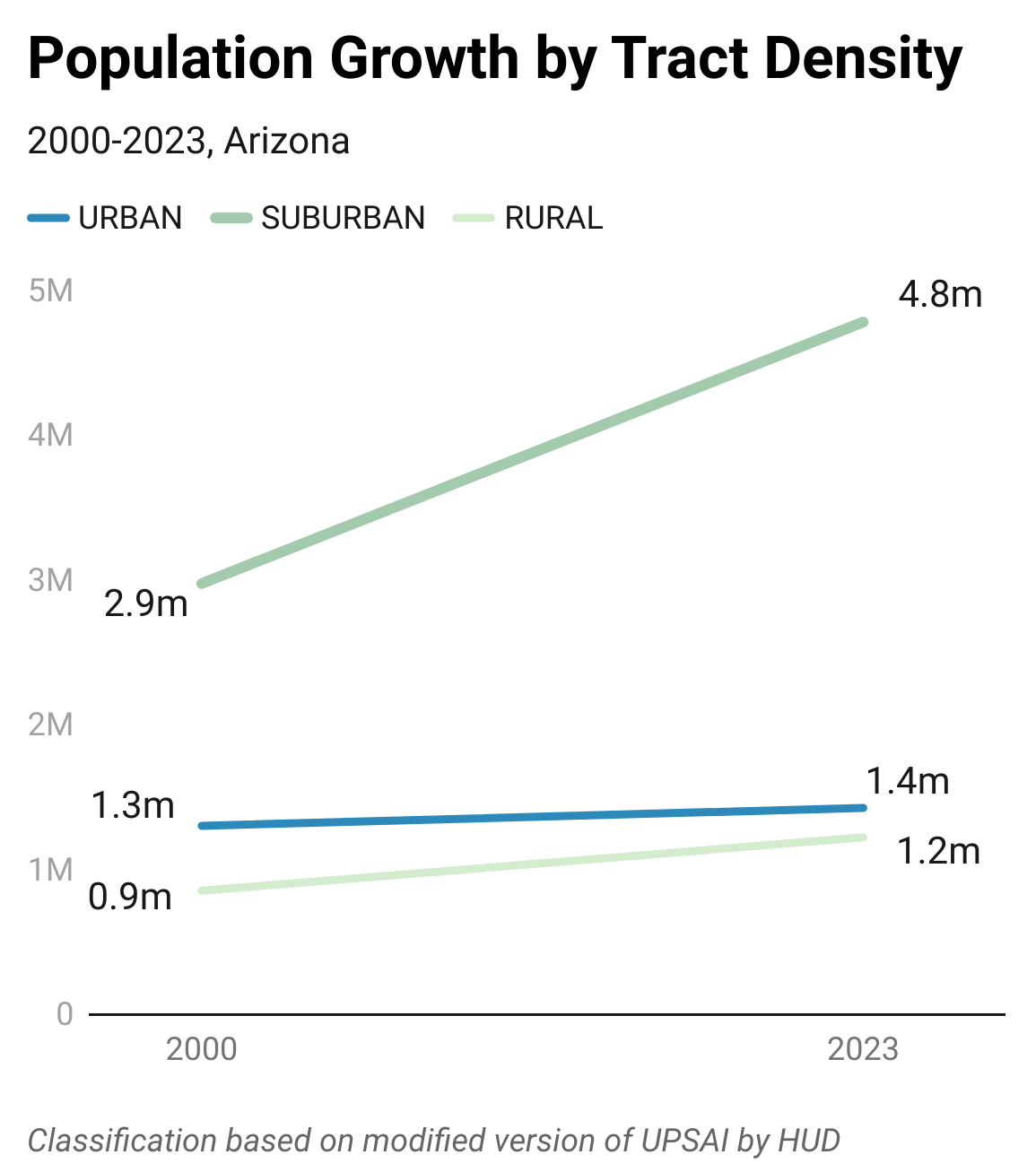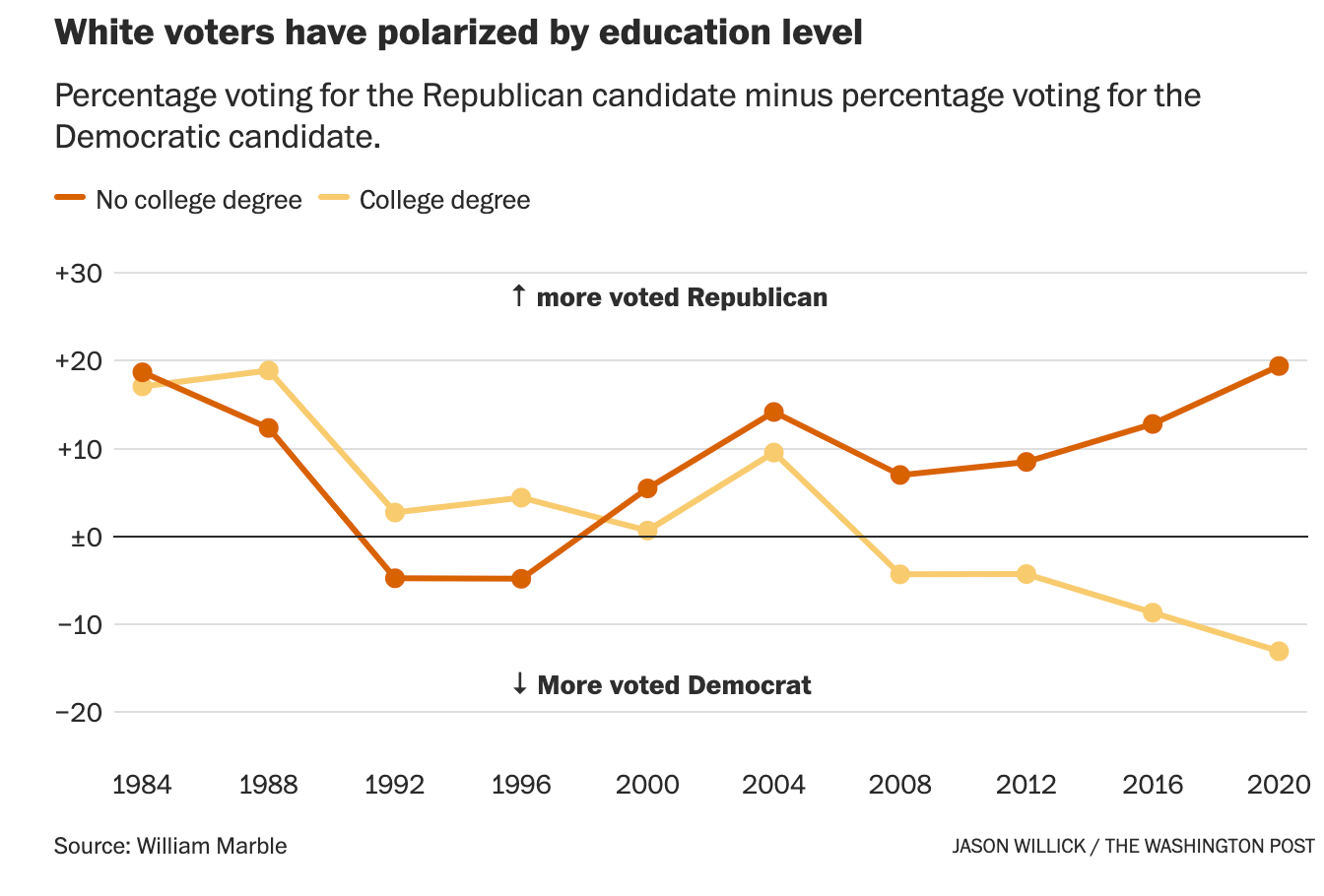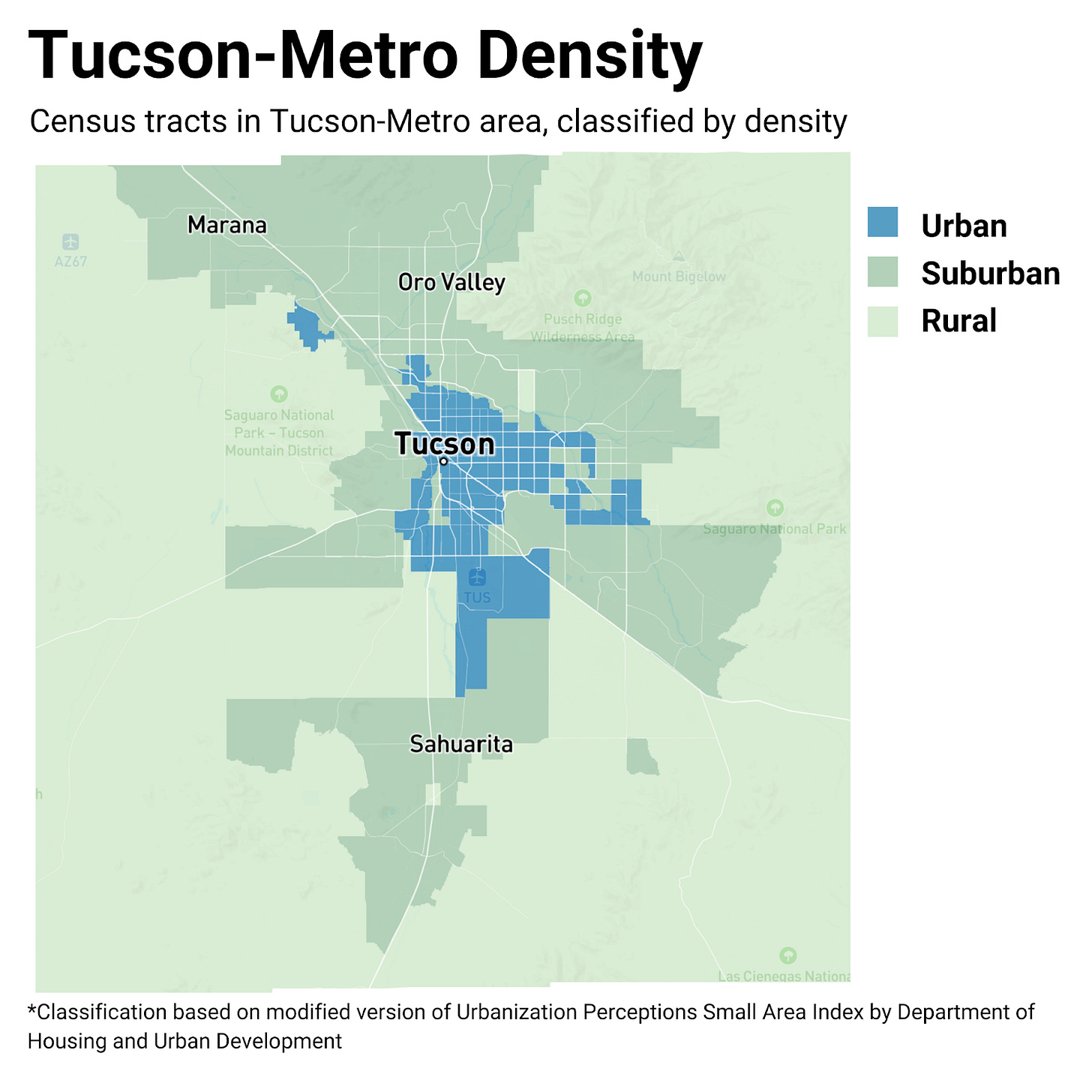Arizona Republicans' Suburban Challenge
Taking a look at Arizona's growing rural/suburban divide.
A note to our readers: Today we are joined by Landon Wall, owner of political consulting firm GrayHouse, Data & Analytics Director for Kari Lake for U.S. Senate, and one of Arizona’s foremost political data experts. As we look towards the election in November, we thought it prudent to give our readers a window into the political demographics of our state, specifically taking a look at our growing rural-urban divide. We hope you enjoy today’s read.
Our content may be free, but we rely on the kindness of everyday benefactors (like you!) to keep the lights on. Everyone on our team — from our editors to our CEO —refuses compensation. All revenue at this stage goes to building a thoughtful and respected news media company that truly represents the spirit of the West. We hope you consider giving today — as little as $5 per month goes a long way (that’s one Starbucks espresso every 30 days!).
Arizona, emblematic of expansive desert landscapes and an ethos of rugged individualism, has witnessed a transformation that challenges its historic identity. In recent years, the state has attracted millions, and not just for its echoes of the Wild West. Home to a booming job market, affordable housing (which is, admittedly, increasingly less the case), and 9 months of mild weather, Arizona has welcomed new residents from across the nation. The state’s once untamed vistas are now marked by ever-expanding urban sprawl. Massive suburbs lined with rows of cookie-cutter homes and streets buzzing with Chevy Suburbans ferrying kids to and from soccer practices have come to define Arizona, at least for the vast majority of the state’s residents who reside in and around metro Phoenix and Tucson.
The growth of Arizona’s suburbs has been meteoric. From 2000 to 2023, the suburban population grew 68%, from 2.9 million to 4.8 million. Rural and urban areas have grown as well, but modestly in comparison to suburban areas, which account for 79% of Arizona’s population growth over that time period. Now, 64% of Arizona’s population resides in suburban areas, with only 19% in urban areas, and 16% in rural areas.
With a majority of Americans living in suburban areas, the trappings of suburban life have become the norm in the United States. But Arizona has become uniquely suburban. According to modeling based on HUD’s Urbanization Perceptions Small Area Index, Arizona’s rapidly expanding suburbs have made it the 5th most suburban state in the entire country.
The growth has largely been driven by families fleeing high cost-of-living blue states like California, Illinois, and Washington, immigration from Mexico, and retirees seeking a warm and affordable place to spend their golden years. At face value, this seems like business as usual for Arizona. But recently, this influx of new residents has begun to play a serious role in altering the fabric of the state’s politics. Politics seem to be heading in a direction that is more akin to the states that many of Arizona’s new residents immigrated from, than back towards the state’s cultural roots.
This shouldn’t come as a surprise when as of 2024 only 38% of Arizonans were actually born in Arizona. The only states that have a lower native population are fellow Sun Belt states, Florida and Nevada (states with similarly massive suburban populations). Conservatives long feared that this steady flow of new residents from liberal states and its growing Hispanic population was a perfect storm to damage the state’s ruby red political status, but for decades Republicans endured. While Republicans kept control of Arizona’s State Legislature and most statewide and federal offices, it felt like fears were misplaced, and in fact, people were moving to Arizona because they were seeking out the conservative policies that made the state attractive to millions of people.
That perception changed fast after the 2016 election cycle.
That year, Arizona saw a decoupling of suburban voter preference from rural voter preference — a gap that has continued to grow each election cycle and has wrought havoc on Arizona’s political order.
Just a decade ago, Republicans held a strong grip on Arizona’s suburbs, with Republicans in competitive races winning those areas by a 12% margin in 2012, and a 17% margin in 2014. At that time, rural and suburban voters were voting nearly in lockstep with one another, with only a 1% separation between Republican performance in rural and suburban precincts. The combined GOP strength in these areas laid the groundwork for double-digit statewide victories by the likes of Jan Brewer in 2010, Mitt Romney in 2012, Doug Ducey in 2014, and many others.
However, in 2022, Republicans would win the suburbs by just 4%, a 8% leftward shift from 2012. While they maintained their strength in rural areas — winning by 19% — the 2016 elections saw voting patterns in suburban areas diverge aggressively from rural areas. Suburban and rural voters would continue to grow apart into the 2022 election cycle, with the split between Republican performance growing from 1% in 2012 to 16% in 2022.
This realignment has thrown Arizona into the swing state category, leaving many Republicans running in fiercely competitive contests from the top of the ballot all the way down to county positions and legislative seats. While Republican performance has steadily improved in rural areas, it simply is not enough to offset losses in the suburbs if they were to continue. In the 2020 Presidential election, 69% of the total votes came from suburban areas while only 17% came from rural areas.
To win statewide in Arizona in 2024, Republicans need a unique message for a suburban electorate that is larger and more discerning than ever before. This isn’t to say that Republicans should abandon the rural vote. In fact, without the rural vote, winning Arizona isn’t possible. However, it is to say that a coalition has to be built between a sufficiently large number of suburban voters and the rural base.
The importance of building a winning coalition with suburban voters goes beyond statewide races. 18 of Arizona’s 30 legislative districts are majority suburban, as well as 7 of 9 of Arizona’s Congressional seats.
These trends have set Arizona up for its most competitive fight over the state legislative majority in modern history, with Democrats and Republicans already gearing up to battle for a relatively small number of competitive seats. Of Arizona’s 6 competitive legislative seats, all are majority suburban except one. Also on the map in 2024 are majority suburban, toss-up Congressional contests in Districts 1 and 6, where incumbent Republicans Rep. David Schweikert and Rep. Juan Ciscomani are seeking to improve on narrow victories in 2022 and help Republicans maintain their US House Majority.
What’s Happening to the Suburbs?
A large part of the suburb's transformation into a battleground can be directly attributed to the politics of Arizona’s new residents.
Over the last 12 months, Arizona has seen around 160,000 new voter registrants, the vast majority of which are new residents, with 65% of those new registrants living in suburban areas. Of the new registrants in the suburbs, 55% registered as unaffiliated or “no party preference.” This surge in independent registration has made independents the largest bloc of voters in Arizona as of July 2023 and flattened a historical Republican registration advantage in the suburbs.
Republicans and independents now account for the same share of registered voters in the suburbs, and while Republicans maintain a turnout advantage, the weight of independent voters is larger than ever.
Independents as a whole are a complicated group, with polling in Arizona over the last year pointing to around 40% voting reliably for Democrats, 40% voting for Republicans, and 20% being true swing voters. Due to this mix, they have served to soften Arizona’s suburbs for Republicans, with Democrats winning over persuadable independents in recent elections.
In 2016, exit polls showed that Donald Trump won Arizona’s independent voters by a 4% margin. In 2020, Trump would lose the same group by a 9% margin. This group has shown that it is capable of significant swings from election to election, and being on the right side of that swing is key to winning in Arizona.
In addition to political changes, Arizona’s suburbs are also changing socioeconomically. Arizona's remarkable growth over recent decades can be attributed to an economy that has magnetized high-paying jobs in sectors like financial services, technology, healthcare, and advanced manufacturing. This boom has drawn in a workforce that commands higher salaries and possesses higher education levels. As a result, large portions of Arizona’s suburbs are not only growing in population but are also becoming significantly more affluent than other parts of the state.
Recent census data shows that 38% of adults over 25 in Arizona’s suburbs have obtained a 4-year college degree or greater. In 2000, 24% of Arizonans held a bachelor’s degree or greater, in 2024, that number had grown to 33% with the vast majority of that growth occurring in the suburbs.
This growing population of college-educated voters, spurred on by the state’s economic progress, has become a problem point for Republicans.
According to data from Catalist, in 2012, Mitt Romney won college-educated voters by 10%- winning 54% to Obama’s 44%. Just 8 years later, Joe Biden would win Arizona’s college-educated voters by an 8% margin- an 18% shift over the course of just 2 Presidential Elections.
Controlling for precinct-level demographic and socioeconomic factors such as age, income, race, crime, married population, and population density, a regression analysis revealed that the share of a precinct’s adult population that had attained 4-year college degrees stood out as the most significant factor influencing the recent political shift in suburban areas.
Precincts with higher percentages of college-educated adults showed a greater shift towards the Democratic Party between 2012 and 2022.
What is happening in Arizona mirrors one of the most important national trends of the last decade: white college graduates have become a solidly Democratic bloc of voters in recent years, and those without 4-year college degrees are gravitating toward Republicans.
Another trend making the suburbs more dynamic is the steady growth of Latino voters as a share of the electorate. In 2020, Latino voters accounted for 18% of turnout statewide, a meaningful increase from the 14% share Latinos made up in 2012.
While Latinos made up 18% of turnout in 2020, they account for 25% of Arizona’s voting age population and are becoming a more politically active voting bloc over time. In 2012, only 40% of eligible Latino voters turned out to vote, and in 2020 that increased to 51%.
Latino voters in the suburbs make up the largest share of this group, and unlike the trends outlined above, there are signs that Latino voters in Arizona’s suburbs are actually becoming more conservative. In 2012, Latino voters in the suburbs voted for Obama by a 32% margin, in 2020 that group voted for Joe Biden by a 21% margin.
These trends look to be accelerating into 2024, with recent aggregated national polling showing Biden leading Trump by just 10% among Hispanic voters. This would be a 14% shift towards Trump compared to the estimated 2020 result among Hispanic voters if it holds true in November, and would lend further credence to a potential political realignment among working-class Hispanic and Latino voters.
The growth in Arizona’s Latino population serves to complicate the trajectory of Arizona’s suburbs as a growing population that is concurrently growing more conservative over time is still likely to soften the Republican advantage in the suburbs in the near term, however, over the long term a significant realignment among Hispanic voters would be a major factor in keeping the state’s suburbs competitive.
Republicans In Position to Gain Ground in the Suburbs
Despite the trends laid out in this article, 2024 has put Republicans in a perfect position to reverse course and regain a foothold in Arizona’s suburbs.
Polling over the last 2 months indicates a positive shift for Republicans, with the data from aggregated national polls revealing that in a match-up against President Joe Biden, Donald Trump has improved his support among suburban voters. He's now trailing Biden by just 1%, marking a 9% improvement from his estimated 2020 margin of -10% among this group.
There are even more positive indicators at home, with polling in January conducted by J.L. Partners showing Republican U.S. Senate candidate Kari Lake leading Democratic opponent Ruben Gallego by 5% among suburban voters.
In that same poll, 53% of suburban voters listed “Border security & illegal immigration” as a top issue, 52% selected “Inflation and the economy,” and 32% selected “Crime, public safety & homelessness.” Polling conducted by Cygnal in 36 battleground Congressional Districts in January 2024 reiterates the same issues as top issues for suburban voters. Among the suburban voters Cygnal surveyed, their top issue was “inflation and the cost of living” with “border security” closely following.
On the issue of “inflation and the cost of living,” suburban voters responded that they trust Republicans more than Democrats to solve it by a 6% margin. On “border security,” suburban voters trust Republicans over Democrats by a 24% margin. And on crime, suburban voters trust Republicans over Democrats by a 16% margin. Among these voters, only 37% approve of the job Joe Biden is doing as president, with a net approval of -18%.
The table is set for Republicans to make significant inroads in Arizona’s suburbs. Faced with one of the most unpopular Presidents in modern American history and an electorate that cares deeply about issues they trust Republicans to address, conservative candidates are well-positioned to take back some ground in the state’s growing suburban communities.
The path to Donald Trump winning the Presidency and Republicans retaking the Senate majority runs directly through Arizona’s suburbs, and understanding the political weight of these voters is critical to winning in November.
Landon Wall is the owner of the political consulting firm GrayHouse and is the Data & Analytics Director for Kari Lake for U.S. Senate.
Methodology: Census tracts were classified into rural, urban, and suburban-based on HUD’s Urbanization Perceptions Small Area Index. An additional model was created using a natural logarithm of the number of people living in a census tract compared to the total area of the census tract using 2022 ACS population data. The results of these two models were averaged and then aggregated into voting precincts creating the final classifications. Precinct-level election results for statewide contests from 2022 to 2008 were aggregated onto 2022 Precinct shapefiles using my spatial aggregation package and merged with the results of the density classification model. Maps were created using R and Mapbox.
















